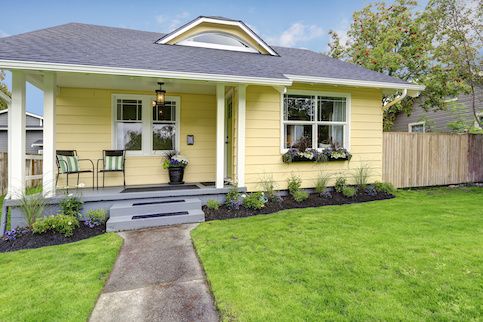Assumable Mortgages: A Guide For Home Buyers and Sellers

Today’s mortgage interest rates may be high enough for many to find it challenging to buy a new home. This is understandable since the mortgage rate makes such a difference to the lifetime cost of the loan. Many home buyers wish they could go back in time to just a few years ago, when rates were far lower.
But what if that option actually existed? In a way, it does. It’s called an assumable mortgage.
What Is An Assumable Mortgage?
An assumable mortgage allows a buyer to take over the seller’s mortgage. You still have to close the deal and take over the title — much like a traditional mortgage process — but when it’s done, you take over the payments on a monthly basis.
If you assume someone’s mortgage, you’re effectively taking over the mortgage from the seller. Assumable mortgages are most common when the terms currently available to a buyer, such as high interest rates, are less attractive than those previously given to the seller. Assumable mortgages also factor into divorce scenarios when the spouse who gets the house is on the title, but not initially on the loan, for example.
See What You Qualify For
Home Purchase
Home Refinance
Tap Into Equity
What Are The Costs Of An Assumable Mortgage?
Aside from the usual closing costs you would normally pay on a mortgage, there may be other costs you’ll have to cover either immediately at closing or, depending on the type of loan and how it’s structured, for the life of the loan.
Assumption Fees
When you do an assumption, lenders often charge a fee. It may be a flat amount or a percentage of the unpaid principal balance. The fee that can be charged may be limited by state laws and regulations, so check the rules in your jurisdiction.
Mortgage Insurance Payments
If the seller made less than a 20% down payment on a conventional home loan and sells the property prior to reaching 20% equity, the buyer will have to take on that monthly payment for private mortgage insurance (PMI). The person assuming the mortgage can request the removal of PMI once they reach 20% equity based on the original payment schedule or by speaking with their lender to discuss what options they may have.
If you’re getting an FHA loan, you’ll have to pay mortgage insurance premiums (MIP) instead of PMI. Unless the original buyer made a down payment of 10% or more, MIP sticks around for the life of the loan. If they did make a down payment of at least 10%, MIP is still paid for 11 years.
USDA loans have guarantee fees which function similarly to MIP, although they’re slightly cheaper. However, you’re stuck with them for as long as you have the loan.
VA loans typically have a one-time funding fee that can either be paid at closing or financed into the loan rather than mortgage insurance. When you assume a VA funded mortgage, the funding fee is 0.5% of the existing mortgage balance and you must pay it at closing or have it added to the loan amount. There are three major funding fee exemptions:
- Those receiving VA disability
- Surviving spouses receiving Dependency and Indemnity Compensation (DIC)
- Active-duty Purple Heart recipients
A Special Caution For VA Assumable Loans
There’s one special note for those who might be looking to have someone assume their VA loan. Although anyone can assume a VA loan, even those without the usual military service required to obtain the loan initially, the only way to have your VA entitlement restored so that you can buy another home with a VA loan is to have the home assumed by a fellow eligible active-duty service member, reservist, veteran or surviving spouse.
What Types Of Mortgages Are Assumable?
Not all mortgages are assumable. Conventional mortgages (those originated by lenders such as banks or mortgage finance companies and then sold in the secondary mortgage investment marketplace) may be more difficult to assume. Government mortgages such as FHA, VA and USDA mortgages are assumable.
The loan may be assumable by a qualified buyer as a conventional loan if it’s an adjustable-rate mortgage (ARM) and the fixed period is over. In the case of FHA and VA loans, the loan can either be fixed or adjustable.
It should be noted that in cases of inheritance or property transfer not involving a sale, assumption is sometimes easier. If you find yourself in this situation, it will be helpful to speak with the servicer of the mortgage about your options.
FHA Loans
FHA loans are backed by the Federal Housing Administration (FHA). Unless the mortgage owner originally put at least 10% down on the loan, you will continue to pay the monthly mortgage insurance premiums (MIP) for the life of the loan. If there was an initial 10% down payment, the MIP payments continue until the loan reaches 11 years.
VA Loans
VA loans are backed by the Department of Veteran Affairs (VA) and help veterans, active-duty service members and eligible surviving spouses find affordable homes. There is no mortgage insurance attached to VA loans, but when you assume a VA funded mortgage, you’ll usually pay a 0.5% funding fee at closing.
Anyone, even people with no military connection, can assume a VA loan. However, sellers of a home with a VA loan should only allow their mortgage to be assumed by another qualified service member if they want to get another VA loan because it can affect their VA entitlement if the buyer is not qualified.
USDA Loans
USDA loans are backed by the U.S. Department of Agriculture (USDA) and help low-income borrowers in rural neighborhoods find affordable housing. USDA loans have guarantee fees which function similarly to MIP, although they’re slightly cheaper. These fees remain in place for the life of the loan.
Find out if an FHA loan is right for you.
See rates, requirements and benefits.
How To Assume A Mortgage
Mortgage assumption isn’t as seamless as agreeing to take over a seller’s mortgage, and although the process is similar to getting a regular mortgage, there are a few hurdles to clear.
1. Ask The Lender If The Mortgage Is Assumable
The current mortgage’s original lender has to approve the new buyer before it will sign off on the assumption. The lender will review the buyer’s credit score, credit history, income and debt-to-income ratio. In addition, sellers must be up to date on their mortgage payments. Even if a buyer may be deemed creditworthy to take on the payments, mortgage investors (Fannie Mae, Freddie Mac, FHA, VA, etc.) often have to approve the assumption.
2. Make Sure You Can Cover The Upfront Costs
Along with the amount you’ve agreed to pay the seller as part of your purchase agreement, you may be required to pay an assumption fee that can be a fixed amount or a percentage of the outstanding mortgage balance.
In addition to assuming the monthly mortgage payments, you must also be able to pay any monthly mortgage insurance fees on a USDA or FHA loan, or the VA upfront funding fee.
3. Submit Your Mortgage Loan Assumption Application
A mortgage loan assumption is similar in all important ways to getting a new mortgage loan. Each lender will have their own protocols.
4. Complete The Underwriting Process
An assumed mortgage goes through a similar underwriting process, in which all of your financial documents are reviewed and vetted as a regular mortgage. Often their standards are higher for an assumed mortgage, which means the process can take a little longer.
What Are The Advantages Of Offering An Assumable Mortgage For Sellers?
In a high interest rate environment, a seller with a locked down mortgage at a much lower rate can use the assumed mortgage route as a key selling point. In a way, it offers buyers a time machine that takes them back to when rates were much lower.
A significantly lower interest rate on a 30-year mortgage can save the buyer tens of thousands of dollars over the course of the loan. A buyer who knows this might be more willing to up their offer on the price of the house.
Find A Mortgage Today and Lock In Your Rate!
Get matched with a lender that will work for your financial situation.
What Are The Pros And Cons Of Mortgage Assumption For Buyers?
Pros Of An Assumable Mortgage
- Lower interest rates: If the current mortgage has an interest rate that is even two or three points lower than the current rate, the savings in interest payments over many months or years can be worth thousands.
- Lower closing costs: If you assume a mortgage, you could also see significant savings in closing costs. The lender will not need a new appraisalbecause the mortgage is in place, offering significant savings. The FHA, VA and USDA as well as some states impose limits on assumption-related fees in order to keep these mortgages affordable.
Cons On An Assumable Mortgage
- Upfront costs still significant: Given the combination of your purchase price and assumption fees, your initial investment might be a large number. If you don’t have that much cash, you’ll have to take a second mortgage at current rate to cover the shortfall.
- You’ll have to assume mortgage insurance payments: Most FHA and all USDA loans will include a monthly mortgage insurance payment in addition to the mortgage payment itself. If you’re assuming a VA backed mortgage, you’ll pay a 0.5% one-time funding fee upfront. If it’s a conventional loan, PMI payments can be removed once you reach 20% equity based on the original amortization schedule and possibly sooner if you pay down the loan or make improvements. Talk to your servicer.
- Less negotiating power: When you assume the mortgage, you must work with the existing lender, which limits your ability to research or try to negotiate a better deal with other lenders.
- Lender may not approve: Even if the loan is assumable, you still have to meet the credit standards of the lender and often the investor in the mortgage. Qualification isn’t assured.
How Do Assumable Mortgages Work After Divorce Or Death?
What happens to the marital home can be one of the most contentious parts of a divorce settlement. In many cases, if both spouses are co-mortgagees, one spouse can transfer ownership to the other with a quitclaim deed.
However, if one spouse is awarded the home and ownership is transferred solely to them, leaving the current mortgage intact, the person staying in the home takes responsibility for the mortgage through the assumption process.
If you were to inherit a home, you can continue to make the payment under the current terms of the loan and have your name put on the mortgage without having to qualify. This is because you’re legally considered a successor in interest. This helps if you want to keep a family home but fear you might not qualify for the mortgage. However, if you want to refinance, your name will have to be on the loan and you’ll have to qualify in the regular way.
Assumable Mortgage FAQs
Can I use an assumable mortgage to purchase a home from a family member?
There are times when a family member will simply take over the payments on a mortgage. An example might be when an elderly person is moved into a nursing home and, rather than selling the house, a family member assumes the mortgage. In such a case, however, the elderly person is still the legal owner of the house. To become the legal owner and take over the responsibility of the debt associated, the family member would have to get the title changed and go through the normal assumption process.
As a seller, can I check to see if my mortgage is assumable?
Check with your lender. Some mortgages are easily assumable, but some lending institutions explicitly bar loan assumption and will have language in the contract that requires the seller to pay off the loan when they sell the property.
Are there fees with an assumable mortgage?
There are assumption fees charged by lenders that may be limited by mortgage investor policy and state rules. You’ll still pay other closing costs as in any mortgage closing, but these are usually less because there is less paperwork and typically no appraisal fee.
Will My Rate Go Up If I Assume A Mortgage?
Not unless the language of the mortgage contract stipulates it, as does happen, though it’s rare. One of the top reasons for assuming a mortgage is that it was more than likely closed at a much lower interest rate than what’s available to you now. It’s important to note that ARM rates can always adjust at times specified in the mortgage contract.
The Bottom Line
Most FHA, VA and USDA mortgages are easy to assume, though each is treated differently. Some conventional loans are harder to assume. When you assume a mortgage, you take on the exact terms, including the interest rate, monthly payment and any mortgage insurance payment. The mortgage closing process is slightly different, but in the end you are the legal owner of the property.
If you’re looking for an affordable mortgage you should to find the loan that’s right for you.
Find A Mortgage Today and Lock In Your Rate!
Get matched with a lender that will work for your financial situation.











